If you know ducks well, you’ll know they come in various breeds, shapes, sizes, and colors. They can have differently shaped bills, unique eye colors, and other characteristics that make them stand out from each other.
One the the easiest ways to try to tell duck breeds apart by sight is by the color of their plumage. Duck feathers come in many different shades and combinations, and not all of them are one solid color.
Ducks with a mix of black and white coloring are unique to look at and more common than you might realize. Let’s take a closer look at duck breeds that are known for their blend of black and white plumage.
Table of Contents
1. Magpie Duck
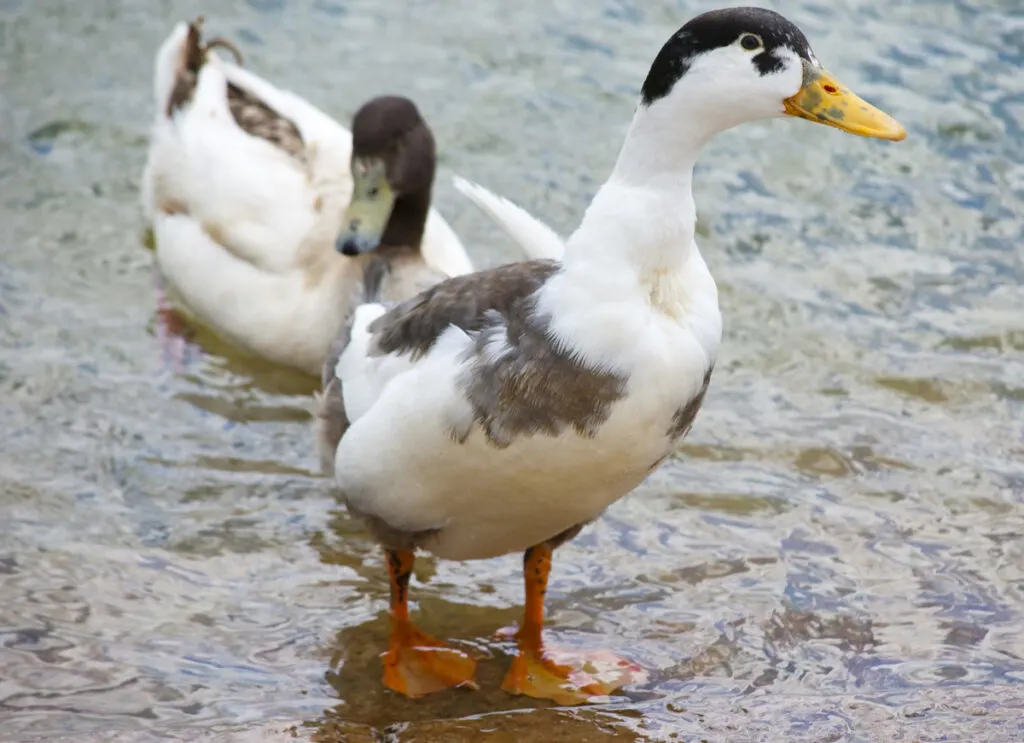
Magpie ducks were developed in Wales toward the end of the First World War. M.C. Gower-Williams and Oliver Drake are credited with the development of this breed in the United Kingdom.
The Magpie breed is thought to have originated from the Huttegem and Indian Runner Duck breeds. The Huttegem was an old Belgian breed that may have gone extinct in 2011.
Magpies are domesticated lightweight ducks weighing around 4-5 pounds. A large part of their plumage is white, but it is variated with black patches.
They also have black feathers on the top of their head, their back, and scattered on their wings. Their bills and feet are yellow or orange, but as they get older, they may become green.
While they were prevalent in the United Kingdom in the early 1900s, they didn’t debut in the United States until 1963. In 1977, Magpie ducks became recognized by the American Poultry Association. Their conservation status was listed as critical in 2007.
Magpies are quite the foragers; they hunt for most of the things they eat. They eat grass, insects, slugs, seeds, and snails.
Magpies ducks are kept for their meat and eggs. They lay 220-290 eggs per year and live for up to 9 years. Magpie ducks are active and easy to control.
2. Ancona Duck
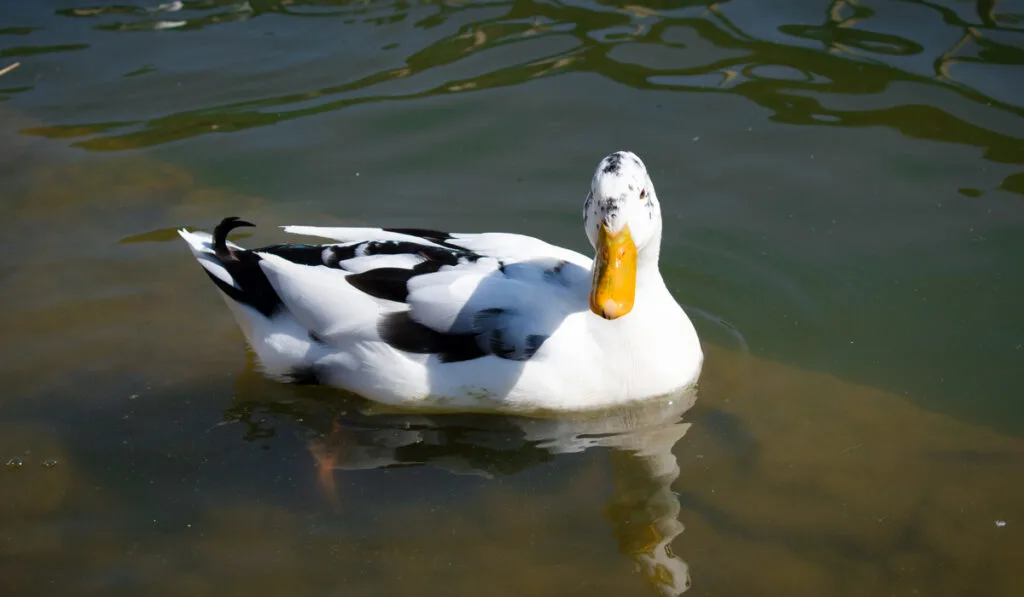
Ancona ducks may have originated from either Great Britain or the United States in the early 1900s. Like Magpie ducks, Ancona ducks are thought to have descended from Huttegem and Indian Runner ducks.
Ancona ducks have plumage with two-toned, black and white feathers. Most of their plumage is white, but you’ll find black patches accenting their cheeks, face, cap, back, sides, wings, and shoulders. Their bills and feet are yellow with some black patches.
Ancona ducks are medium-sized domestic ducks with an average weight of 6-6.5 pounds. Compared to the closely related Magpie ducks, Anconas are sturdier.
This duck breed is commonly kept for their eggs and meat, and they lay as many as 210-280 white eggs per year. The eggs can also be tan, cream, spotted, or blue.
You’ll rarely find Anconas flying. They are active but unlikely to wander far from home. Ancona ducks are also great foragers, and they usually supplement any feed you provide with bugs, grass, seeds, weeds, and worms.
3. Muscovy Duck

Muscovy ducks are one of the oldest domesticated fowls in the world. Wild Muscovy ducks live in Argentina, northern Mexico, and southern Texas in coastal regions and lowland areas.
Muscovy ducks are also widely domesticated throughout North America and can be found on farms and in parks.
Male Muscovy ducks are the largest ducks in North America. They have predominantly black plumage with white patches in their wings.
The black feathers on their backs have green iridescence, their faces have red warts, and they have dark grey bills and feet.
Female Muscovy ducks are large bodied and predominantly black. They have long necks, white patches in their wings, dark-grey bills, and dark grey feet.
They feed on plants and animals. Some of these include seeds, sedges, tubers, grasses, insect larvae, spiders, reptiles, and fish.
They are typically raised for their meat, but some farmers keep them on hand to drive away snakes and mice.
On average, Muscovy ducks lay 8-15 eggs per nesting with an incubation period of 30-31 days. Their eggs are usually glossy white but sometimes have a buff or greenish color.
4. Pomeranian Duck
Pomeranian ducks originated from Pomerania in Germany as a crossbreed. They share an ancestry with some northern European ducks including Shetland ducks and Swedish Blue ducks, and they are considered quite rare.
Pomeranian ducks are landrace ducks. They are found in gardens, poultries, and farms across northeastern Europe especially between Germany and Sweden.
Pomeranian ducks come in blue and black varieties. Pomeranian ducks with black plumage have a green sheen and a white patch around their breast region. Their eyes are dark brown, and their bills are black.
They are kept for ornamental purposes, for eggs, and for meat. On average, they lay 70-100 white or blue eggs every year. Their eggs have an incubation period of 26-28 days.
One interesting fact about Pomeranian ducks is that they are known to quack loudly to welcome visitors. This makes them useful as guard animals.
Pomeranian ducks eat both plants and insects. They feed on various bugs, slugs, rice bran, and snails. Most Pomeranian ducks live for 4-8 years, but some have lived for up to 12 years.
5. Crested Duck
Crested ducks get their name from the tuft of feathers atop their heads. This breed comes in a variety of different plumage colors. They can be all white, all black, or a mix of black and white.
Crested ducks are medium-sized waterfowl that have been around for over 4 centuries. They entered the United States in the mid-1800s. The white variety was admitted into the American Poultry Association’s standard in 1874, and the black variety was added in 1977.
Crested ducks are kept for 2 main reasons: eggs and meat. They lay cream-colored eggs with a clutch size of 5-8 and an incubation period of around 30 days. Crested ducks are friendly, calm, and they grow quite fast.
6. Tufted Duck
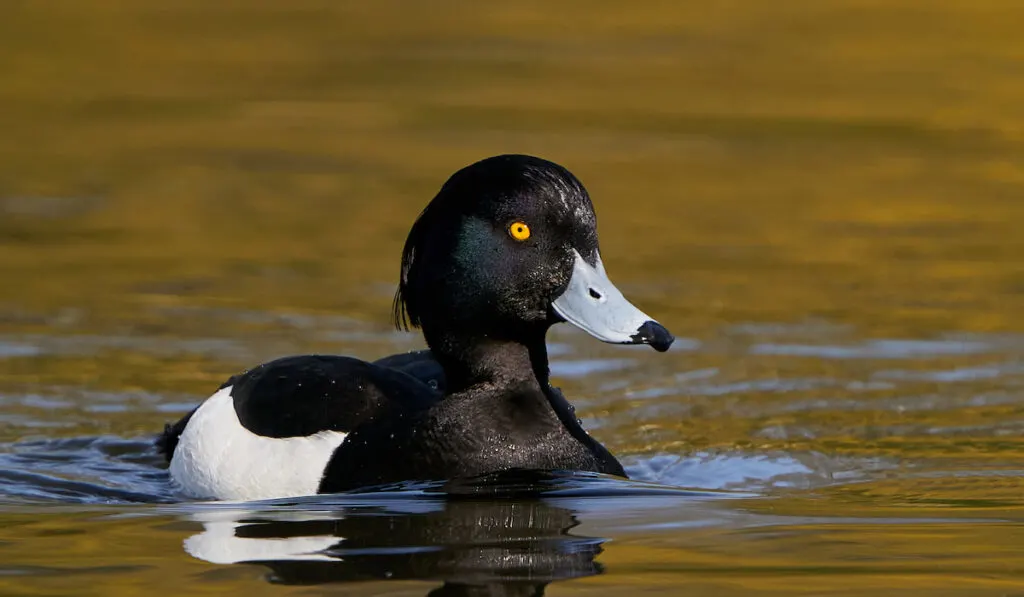
Tufted ducks originated in the Palearctic region, but you can now find them in parts of Africa, Eurasia, and North America. Tufted ducks breed between May and August.
During this period, they spend more time in areas such as Norway, the British Isles, Faroe Islands, and almost all of Europe.
In winter, they move toward northern Africa, southern Europe, Southern Asia, and North America.
Tufted ducks occupy temperate saltwater and freshwater. You’ll commonly find them in shallow waters with thick vegetation.
Tufted ducks are medium sized, and the drakes are noticeably larger than the females. The tuft on the back of their head earns them their name, and this is one feature unique to them when compared to other members of the Anatidae family.
Male Tufted ducks have predominantly black plumage, but their underbellies and sides have white patches.
Female Tufted ducks have black plumage with brown and white patches. Both genders have black bills and black and grey feet.
Tufted ducks are monogamous. They build their nests close to water in thick vegetation. On average, they lay between 6-14 eggs per nesting with an incubation period of 26-27 days.
Tufted ducks will eat plants such as seeds, grains, nuts, and tubers, and animals such as mollusks, fishes, and insects.
7. Greater Scaup
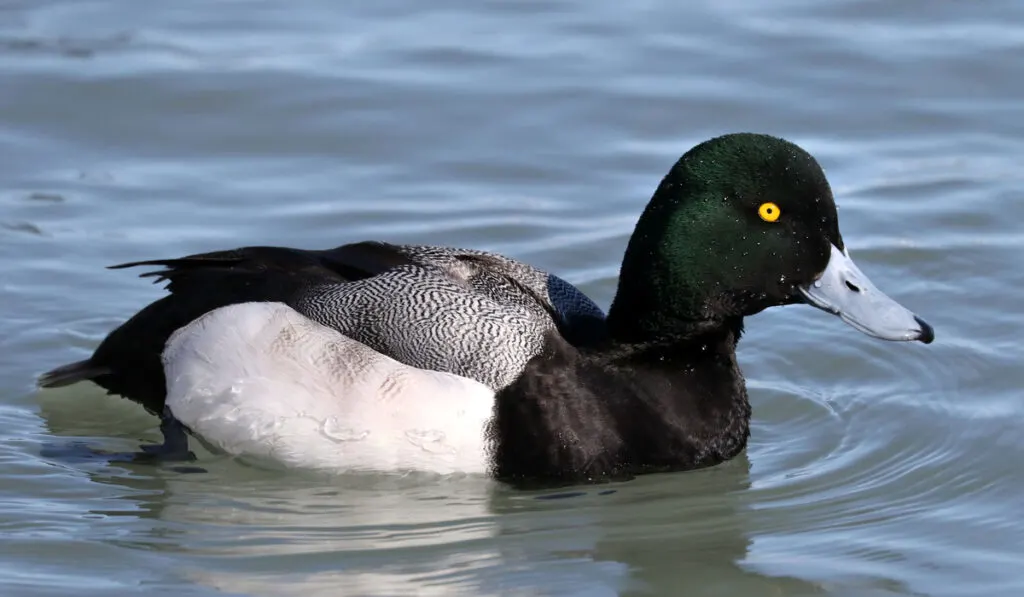
The Greater Scaup is the only diving duck living near one of the Earth’s poles. For spring breeding, they move toward tundra regions in Europe and North America. In winter, they migrate toward the Atlantic and Pacific coasts.
Greater Scaups have rounded heads, blue beaks, and yellow eyes. For the drakes, their plumage is black, their flanks are white, and their back is grey.
The females have brown plumage with white patches around the base of their bills.
They feed on aquatic plants, seeds, insects, crustaceans, and mollusks. They build their nest on the ground in areas close to water with dense sedges and grasses.
Greater Scaups have a clutch size of 5-13 and an incubation period of 23-28 days. Their population is currently in decline in the wild.
8. Bufflehead Duck
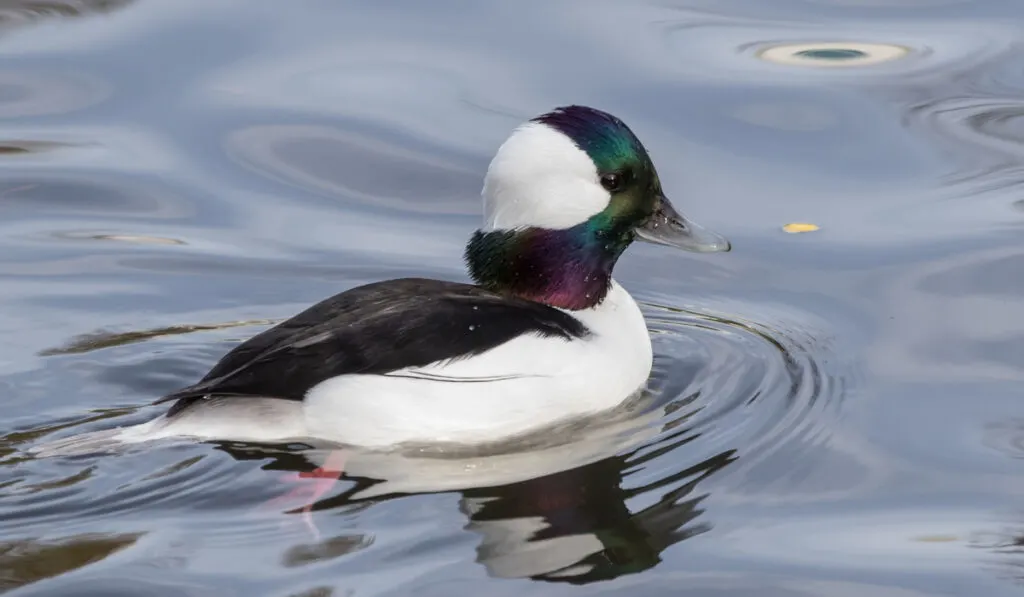
Bufflehead ducks are the smallest diving ducks in North America, and they are commonly seen around lakes and ponds.
You’ll find isolated populations of this breed in the western United States, but they are more common in the aspen parklands and boreal forests of Alaska and Canada.
Male Buffleheads have black and white feathers on their large heads that are easily noticed from a distance. The black feathers around the base of the bill gives off a purple-green iridescence.
Bufflehead ducks females have black to dark brown plumage with a white patch on their cheeks.
While flying, both male and female Bufflehead ducks reveal white stripes on their wings.
Buffleheads mainly eat aquatic invertebrates such as insect larvae, mollusks, and crustaceans. They are great swimmers and divers.
They fly at lower altitudes when above water then dive for between 12-25 seconds to get their food. They usually swallow their catch while underwater, then return to higher altitudes once out of the water and over land.
When fall and winter arrive, Bufflehead ducks incorporate plant matter in their diet. During these seasons, they eat seeds from bulrush and pondweed plants.
This breed lays buff or cream-colored eggs. For each nesting, they lay between 4-17 eggs with an incubation period of 28-33 days.
Resources
- https://www.allaboutbirds.org/guide/Bufflehead/
- https://livestockconservancy.org/index.php/heritage/internal/magpie
- https://www.beautyofbirds.com/magpieducks.html
- https://backyardpoultry.iamcountryside.com/poultry-101/all-about-ancona-ducks/
- https://livestockconservancy.org/index.php/heritage/internal/anconaduck
- https://www.allaboutbirds.org/guide/Muscovy_Duck/
- https://www.breedslist.com/pomeranian-duck.htm
- https://domesticanimalbreeds.com/pomeranian-duck-breed-everything-you-need-to-know/
- https://www.roysfarm.com/crested-duck/
- https://animaldiversity.org/accounts/Aythya_fuligula/
- https://www.rspb.org.uk/birds-and-wildlife/wildlife-guides/bird-a-z/tufted-duck/
- https://www.allaboutbirds.org/guide/Greater_Scaup/
